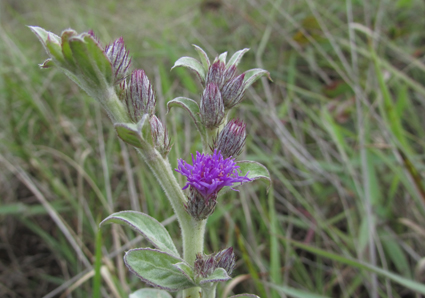Abstract
A new species of Lepidaploa (Vernonieae, Compositae) is here described as L. nakajimae, an endemic species of Maciço do Urucum range, Corumbá, Mato Grosso do Sul state, Brazil. This new species differs from the closely related L. scintillans basically in its leaf width 1.0–2.2 cm (vs. 0.1–0.3 cm), sessile capitula (vs. short pedunculate), florets 40–42 (vs. 10–12), and anthers 2.0 mm long (vs. 3.6–4.3 mm long). Illustrations, comments, distribution map, and conservation status are provided for the new species.
References
- Angulo, M.B. & Dematteis, M. (2012) Cytotaxonomy of some species of the South American genus Lessingianthus (Asteraceae, Vernonieae). Plant Systematics & Evolution 298: 277–285. https://doi.org/10.1007/s00606-011-0542-z
- Angulo, M.B., Vega, A.J. & Dematteis, M. (2012) Nuevas combinaciones en los géneros sudamericanos Lepidaploa y Lessingianthus (Vernonieae, Asteraceae). Gayana Botánica 69: 267–274. https://doi.org/10.4067/S0717-66432012000200006
- Bachman, S. & Moat, J. (2012) GeoCAT – an open source tool for rapid red list assessments. BGjournal 9: 11–13.
- Beentje, H. (2012) The Kew plant glossary: an illustrated dictionary of plant terms. Kew Publishing, Richmond, Surrey, 164 pp.
- Cassini, A.H.G. (1817) Aperçu des genres nouveaux formés par M. Henri Cassini dans la familla des Synanthérés. Quatrième fascicule. Bulletin des Sciences de La Sociéte Philomatique de Paris 1817: 66–70.
- Cassini, A.H.G (1825) Oliganthe, Oliganthes. In: Cuvier, F.G. (Ed.) Dictionnaire des Sciences Naturelles, vol. 36. F.G. Levrault, Strasbourg & Paris, & Le Normant, Paris, pp. 18–20.
- Christenhusz, M.J.M. & Byng, J.W. (2016) The number of known plant species in the world and its annual increase. Phytotaxa 261: 201–217. https://doi.org/10.11646/phytotaxa.261.3.1
- GeoCAT (2022) Geospatial Conservation Assessment Tool. Available from: http://geocat.kew.org/ (accessed: 29 September 2022).
- IUCN (2012) IUCN Red List Categories and Criteria: Version 3.1. Gland and Cambridge, IUCN, 32 pp.
- IUCN (2022) Guidelines for using the IUCN Red List Categories and Criteria: version 15.1 (July 2022). Available from: https://www.iucnredlist.org/resources/redlistguidelines (accessed: 6 October 2022)
- Keeley, S.C., Forsman, Z.H. & Chan, R. (2007) A phylogeny of the “evil tribe” (Vernonieae: Compositae) reveals Old/New World long distance dispersal: Support from separate and combined congruent datasets (trnL-F, ndhF, ITS). Molecular Phylogenetics and Evolution 44: 89–103. https://doi.org/10.1016/j.ympev.2006.12.024
- Keeley, S.C. & Jones, S.B. (1979) Distribution of the pollen types in Vernonia (Vernonieae: Asteraceae). Systematic Botany 4: 195–202. https://doi.org/10.2307/2418418
- Keeley, S.C. & Robinson, H. (2009) Vernonieae. In: Funk, V.A., Susanna, A., Stuessy, T.F. & Bayer, R.J. (Eds.) Systematics, evolution and biogeography of Compositae. IAPT, Vienna, pp. 439–469.
- Kingham, D.L. (1976) A study of the pollen of morphology of tropical African and certain other Vernonieae (Compositae). Kew Bulletin 31: 9–26. https://doi.org/10.2307/4108992
- Lessing, C.F. (1831) De synthereis dissertatio quarta. Linnaea 6: 624–721.
- Mandel, J.R., Dikow, R.B., Siniscalchi, C.M., Thapa, R., Watson, L.E. & Funk, V.A. (2019) A fully resolved backbone phylogeny reveals numerous dispersals and explosive diversifications throughout the history of Asteraceae. PNAS Latest Articles 116: 1–6. https://doi.org/10.1073/pnas.1903871116
- Marques, D., Castro, M.S., Rivera, V.L. & Dematteis, M. (2022) Lepidaploa in Flora e Funga do Brasil. Jardim Botânico do Rio de Janeiro. Available from: https://floradobrasil.jbrj.gov.br/FB16164 (accessed: 28 September 2022).
- Marques, D. & Dematteis, M. (2016) A new species of Lepidaploa (Asteraceae: Vernonieae) from Minas Gerais State, Brazil. Phytotaxa 273: 133–138. https://doi.org/10.11646/phytotaxa.273.2.5
- Melhem, T.S., Corrêa, A.M.S., Makino-Watanabe, H., Cruz-Barros, M.A.V., Silvestre-Capelato, M.S.F. & Esteves, V.G. (2003) Variabilidade polínica em plantas de Campos de Jordão, vol. 16. São Paulo, Brasil, 70 pp.
- Panero, J.L. & Crozier, B.S. (2016) Macroevolutionary dynamics in the early diversification of Asteraceae. Molecular Phylogenetics and Evolution 99: 116–132. https://doi.org/10.1016/j.ympev.2016.03.007
- Punt, W., Blackmore, S., Nilsson, S. & Le Thomas, A. (2007) Glossary of pollen and spore terminology. Available from: http:// www.biol.ruu.nl/~palaeo/glossary/glos-int.htm (accessed: 10 July 2022).
- Qgis Development Team (2021) QGIS Geographic Information System. Open Source Geospatial Foundation Project. Available from: http://www.qgis.org/ (accessed: 31 March 2023).
- Robinson, H. (1988) Studies in the Lepidaploa Complex (Vernonieae: Asteraceae) IV. The new genus, Lessingianthus. Proceedings of the Biological Society of Washington 101: 929–951.
- Robinson, H. (1990) Studies in the Lepidaploa complex (Vernonieae: Asteraceae). VII. The genus Lepidaploa. Proceedings of the Biological Society of Washington 103: 464–498.
- Robinson, H. (2007) [2006] Vernonieae. In: Kadereit, J. & Jeffrey, C. (eds.) Kubitzki’s The families and genera of vascular plants, vol. 8. Springer, Berlin, Heidelberg, New York, pp. 149–174.
- Roque, N. & Bautista, H. (2008) Asteraceae: caracterização e morfologia floral. EDUFBA, Salvador, 73 pp.
- Schreber, J.C.D. von (1791) Genera plantarum, vol. 2. Sumptu Varrentrappii et Wenneri, Francofurti ad Moenum [Frankfurt am Main], 872 pp.
- Susanna, A., Baldwin, B.G., Bayer, R.J., Bonifacino, J.M., Garcia-Jacas, N., Keeley, S.C., Mandel, J.R., Ortiz, S., Robinson, H. & Stuessy, T.F. (2020) The classification of the Compositae: A tribute to Vicki Ann Funk (1947–2019). Taxon 69: 807–814. https://doi.org/10.1002/tax.12235
- Urbanetz, C., Lehn, C.R., Salis, S.M., Bueno, M.L. & Alves, F.M. (2012) Composição e distribuição de espécies arbóreas em gradiente altitudinal, morraria do Urucum, Brasil. Oecologia Australis 16: 859–877. https://doi.org/10.4257/oeco.2012.1604.10


